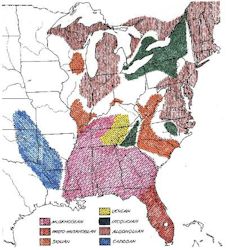
The Siouan Tribes of the East was Mooney’s most speculative work. He began the shorter monograph even before he finished writing his study of the Ghost Dance. An indication of his maturing scholarship was his increasing ability to carry on separate lines of research simultaneously. The study had its roots in the work he accomplished thus far on the Indian synonymy, and in the extensive review of the literature of early exploration most recently incorporated in his article on the Potamic tribes. His inspiration came from the linguistic work done in the early 1880’s by Albert Gatschet, his friend and colleague at the bureau. From a study of vocabularies, Gatschet had tentatively declared the Biloxis of southern Mississippi and the Catawbas of South Carolina to be of Siouan stock. About the time of Gatschet’s Siouan research, Horatio Hale had compiled a list of one hundred words of the Tutelo language. Hale’s informant was an ancient Tutelo, the “last of his tribe,” living with the Cayuga in Canada. Hale conjectured that the Tutelos, onetime residents of Virginia and North Carolina, spoke an older form of a Siouan language. Early Anglo-European interlopers had never bothered to inquire after the identities of the many tribes inland from the larger Algonquian and Iroquoian groups of the southeastern frontier, and by the end of the seventeenth century most of the forty or more tribes in that interior group were extinct and their origins unknown. They had been decimated by disease and in war with their numerous Algonquian and Iroquoian neighbors. Perhaps it could be demonstrated convincingly, Mooney thought, that these tribes were actually part of the parent stock of the archetypal Plains Indians, the Teton Lakota, or Sioux.
Mooney narrated a historical reconstruction based on scanty linguistic evidence, vague and scattered references in the literature of exploration, and a few wild surmises. Tribes in proximity to the Biloxi, Catawbas, and Tutelos he assumed to be Siouan. Since the three tribes were enemies of the Algonquian and Iroquoian tribes, he reasoned, it could also be assumed that other enemies were likely of Siouan origin, as in the case of the Monocan and Monahoac confederacies of Virginia. These warred against the Powhatans. Capt. John Smith had described these Indians as barbarous, warlike, and nomadic, resembling not only the Tutelos but also the western Sioux. The tribal prefixes Ma, Mo, and Mon meant “earth” or “country” in the western Sioux dialects. By grouping known and presumed allies with known or presumed Siouan tribes of the region, Mooney classified close to thirty tribes as part of the Siouan linguistic stock. He mapped their ancient homeland, which closely resembled the region outlined by Hale stretching from South Carolina to the Great Lakes.
Publication of The Siouan Tribes of the East preceded by a year that of Mooney’s study of the Ghost Dance. When it appeared in 1895 it met with immediate criticisms, many of which are sustained to this day. In a symbolic way, The Siouan Tribes of the East took him away from his study of southeastern Indians. It helped to direct his attention westward to the great Sioux Nation and, in time, to other High plains cultures. 1
This manuscript in its entirety can be found through the links below.
Siouan Tribes of the East – Table of Contents
- The southern Atlantic stocks
- Siouan migrations and Iroquois conquests
- The Biloxi Indians
- The Paskagula, Moctobi, and Chozetta
- The Manahoac Confederacy
- The Monacan Confederacy
- Collateral tribes
- The Mahoc Indians
- The Nuntaneuck or Nuntaly
- The Mohetan Indians
- The Meipontsky or Meipousky
- The Saponi and Tutelo Indians
- Collateral tribes
- The Occaneechi Indians
- The Sara and Their Allies
- The Eno, Shoccoree, and Adshusheer
- The Woccon, Sissipahaw, Cape Fear, and Warren-Nuncock Indians
- The Catawba Indians
- The Waxhaw and Sugeree Indians
- The Pedee, Waccamaw, and Winyaw; the Hooks and Backhooks
- The Sewee, Santee, Wateree, and Congaree
- Other South Carolina Tribes
- Cherokee Indians
- Shawano Indians
- Uchi Indians
- Saluda Indians
- Notchee Indians
- Etiwaw Indians
- Westo and Stono Indians
- Edisto Indians
- Coosa Indians
- Cusobo Indians
- Local names from Siouan tribal names in Virginia and Carolina
Citations:
- This page source: Moses, L. G., The Indian Man: A Biography of James Mooney, pub. Univ. of Nebraska Press, 2002, pg. 81-83.[↩]
